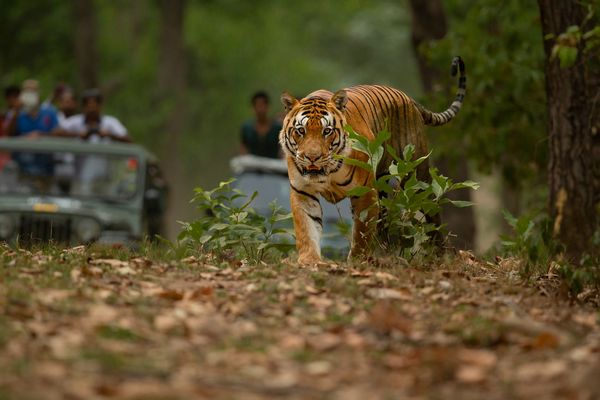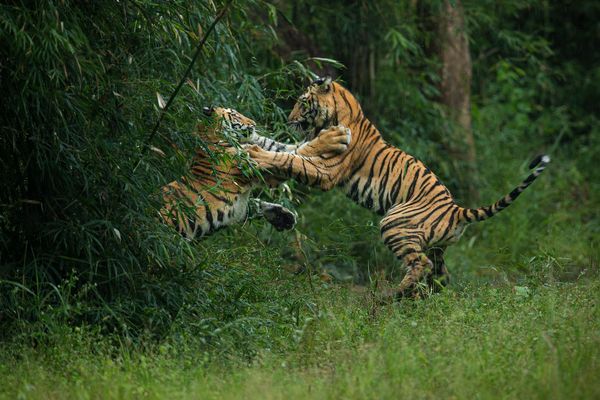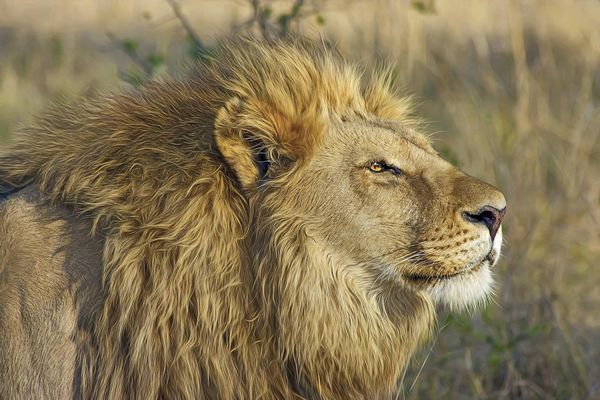Address
304 North Cardinal
St. Dorchester Center, MA 02124
Work Hours
Monday to Friday: 7AM - 7PM
Weekend: 10AM - 5PM
24 Nights / 25 Days
Places to Visit: New Delhi – Leh – Ulley – Ranthambore – Jaipur – Bera – Ahemdabad – Sasan Gir – Rajkot



Let’s plan your perfect tiger safari tour in India. Please fill in the details and our representative will get back to you within 24 hours with a custom-made safari tour package.
Or you can reach us via the following.
Our agent will meet you at the New Delhi Airport when you arrive. He will see to it that you get at the hotel without incident and assist you in checking in. You will receive and receive explanations of all the documents linked to your travel. Stay the night at the hotel.
After breakfast, head to the airport to catch the G8 225 aircraft to Leh, which takes off at 08:40. Our agent will welcome you when you arrive at the Leh airport and drive you to the accommodation. Flying from Delhi to Leh involves a swift elevation change of 3000 m, necessitating the greatest amount of acclimatisation possible for visitors to this region. Spend the night in Leh’s hotel.
Drive down the Indus River the following morning after breakfast in search of waders, dippers, and other birds like ibisbills, harriers, and ducks. Spend the afternoon exploring Leh, which is also known as Little Tibet due to its extensive cultural legacy. Some of Leh’s most well-known tourist destinations include the Shanti Stupa, Leh Palace, and Namgyal Tsemo. Spend the night in Leh’s hotel.
Travel to Ulley, located in the western part of Ladhak and home to the snow leopards, after breakfast. On your way to Ulley through the Himalayas, the largest creation in the world, you will pause for a tea break in Nimoo and have the option of visiting Likir Monastry. Being perched atop a small hill in a valley makes this monastery one of the most alluring locations. after that proceed to Ulley. Once there, register at the hotel. Dinner and a night’s stay at Ulley’s lodge.
Your daily activities will now be determined by the snow leopard’s whereabouts as of this day. You will be hiking and camping all day long, depending on how the Ghost Cat moves. You can set out from the lodge after breakfast and start looking for a Snow Leopard. The resort provides a breathtaking view of the massive cliffs, which are a snow leopard’s ideal home. The scan is initiated with a scope. From the lodge, you might be able to see a snow leopard, wolves, ibex, and other creatures.
If there isn’t a chance, a spotter will already be on duty searching for a Snow Leopard on foot, which takes about two to three hours, at a greater elevation. You can get help from your potter there with the camera and the other equipment. Spend the day seeking about for other lives surviving in such harsh conditions. Every meal and overnight stay at the Ulley lodge.
Everything you do depends on how the Snow Leopard moves. Early in the morning, the search for the Ghost Cat starts from the resort. After breakfast, climb the hour to Sangpo Nala if there is no luck in the region around the resort. The region has a higher success rate than other regions and has traditionally generated amazing sightings. Search the cliffs all day for the Snow Leopard. Because of the incredibly high wind speeds and vapor-carrying winds that pass over the trans Himalayas, there is no rain there.
You will learn about a snow Leopard from each member of the group, which is one advantage of doing the tour here. We will find out about it and travel to the sighting spot even if a villager reports seeing a Snow Leopard. Every meal and overnight stay at the Ulley lodge.
There are also alternate spots nearby, such as the communities of Saspoche and Hemis Shukpachen, if you’ve already spotted a Snow Leopard or haven’t had any luck. In addition, wolves and snow leopards are frequently seen in these two villages. A wolf pack with between 5 and 8 members prowls the area between these villages. They now consider these locations to be their home. During treks and Snow Leopard searches, you might also come across Asiatic Ibex, Himalayan Thar, Blue Sheep, Marmot, Red Fox, Eurasian Lynx, Tibeten Wolf, Palla’s Cat, and many other creatures roaming on the cliffs of the Trans-Himalayas. The greyish coat of the Asiatic ibex makes it camouflage since it nicely complements the colour of the mountains.
After breakfast, leave the lodge with the magnificent memories of the snow-capped mountains and go to Leh to board aircraft SG 124, which departs at 12:20 and arrives in Delhi at 13:40. Our representative will meet you at the airport upon your arrival and assist with your transfer to the hotel. Spend the night at the New Delhi hotel.
After an early breakfast, our agent or driver will pick you up at the hotel and assist with the 390 km, or roughly 7 hour, drive, to Ranthambhore National Park. Arrive and check into the hotel. Dinner, a leisurely evening, and an overnight stay in the Ranthambhore lodge.
Prepare for the Tiger Safari in Ranthambhore first thing in the morning before the sun rises. To begin your morning safari, you will drive to the park’s entrance gate and arrive there before daybreak.
Near the confluence of the Aravali and Vindhya hill ranges, Ranthambore National Park is one of the best areas to see wild animals because the animals are used to the attention they get there. With the inclusion of Sawai Man Sing Sanctuary, the Ranthambhore National Park’s 400 sq km total size increases to around 500 sq km. The park’s name, Ranthambhore, derives from the adobe stronghold that dates back a thousand years and dominates the surrounding forest and open valleys between the Aravalli and Vindhya mountain ranges. Fruit trees and water ponds adorn the valleys in these areas. The natural and historical worlds collide in Ranthambhore, which is well-known for its Tiger Sightings.
nilgai, languor, sambar, cheetal, and chinkara. Visitors have a very good chance of seeing tigers when on a safari in this reserve, which is home to the elusive leopard and tigers. return from the safari at ten in the morning. After eating lunch at the lodge, you’ll head out on a jungle safari to look for the beautiful Tiger. At the Ranthambhore resort, have dinner and spend the night.
Morning and afternoon jeep safari inside the National Park. All meals and overnight at the lodge in Ranthambhore.
In only one park, you may find all the angles, lighting, backgrounds, and many frames. Ranthambhore is a haven for bird lovers with around 300 distinct species of birds. In actuality, Ranthambhore and its surrounds are a bird watcher’s paradise. From their nesting sites north of the Himalayas, large cormorants, painted spurfowls, Sarus cranes, bronzed winged jacanas, sandpipers, kingfishers, nightjars, painted sandgrouses, great horned owls, and many more frequent winter migrants arrive to Ranthambhore and the adjacent areas.
Jeep safari at the National Park in the morning. Check out of the hotel and travel to Jaipur after lunch. The route from Jaipur to Bera would be segmented there. Spend the night in the Jaipur hotel.
After an early breakfast, depart from the hotel and drive the 390 kilometres (about 7 hours) to Bera. Check into the lodge upon arrival. The Jawai Dam is not far from Bera, Rajasthan. It is renowned for its breathtaking leopard sightings. The encounter is distinctive because there are leopards nearby this beach town rather than a forest. The elusive Leopard, the huge Bluebull, the Crocodile, the ever-curious Hyena, the graceful Pelican, the Greylag Goose, the Robin Accentor, Demoiselle Crane, and Barheaded Goose are just a few of the mammals and birds that call Bera home. You may easily share the leopards’ habitat by going on a late-night safari. Dinner and overnight safari in the hotel.
Start your safari early in the morning before sunrise to experience Rajasthan’s golden morning as the sun rises over this parched region. The main draw to the area is the leopard. The Marsh Crocodile is one of the other wildlife species that call this area home, though. What actors they are—15-foot giants that are capable of fooling anyone with their sleepy falsehoods. They might still be as active when they are not doing anything as when they are hunting. They occasionally don’t move and we have to watch out since they mix in with the rusty, muddy ground around the reservoir. They lounge around all day in the heat, and when they are hungry, they just jump into the fish-filled lake. This makes sightings difficult while they are in motion, but they are always noticeable when lying on the shore on a sunny day.
Afternoon again proceed for jeep safari. All meals and overnight at the lodge in Bera.
The final Bera Jeep Safari began in the morning. You will not be able to get over Bera’s boulder-filled landscape. Later, depart from the hotel and drive the 280 kilometres (around 5-6 hours) to Ahmedabad. Once more, Ahmedabad serves as a rest stop on the way to Sasan Gir, home to the Asiatic Lion. check-in at the hotel upon arrival. Spend the night at the Ahmedabad hotel.
After an early or packed breakfast, check out of the accommodation and drive the 350 km—or around seven hours—to Gir National Park. Check into the lodge upon arrival. A jeep safari is scheduled for the afternoon. Dinner and sleeping at the Gir lodge.
Jeep safaris throughout the morning and the afternoon within the National Park. The local guides in this area are quite knowledgeable about the parks. Because they are familiar with the region of each lion, one can determine where to go. Since birth, they have been observing these lions. Gir National Park is the only place outside of Africa where lions can be seen in their native environment. Gir lions are stunning animals with an average length of 2.75 metres and larger elbow tufts, belly folds, and tail tassels than their African cousins, who have thicker manes. Gir is also home to 350 species of birds and 38 species of animals in addition to lions.
This is also an area that has around a total number of 1000 big cats in and surrounding the National Park. The last record says that Sasan Gir has around 500 lions and the same number of Leopard as well.
In-park jeep safaris in the morning and the afternoon. Every meal and overnight stay at the Gir lodge. The largest continuous area of dry deciduous forest in the country is protected by the Gir National Park and Sanctuary in Gujarat’s Saurashtra region. 1412 square kilometres make up its entire surface. Gir has developed to be home to a very stable ecosystem with incredible regenerating, self-supporting, and self-sustaining capacity thanks to its abundance of biodiversity, which includes 606 different plant species, 39 species of mammals, 37 species of reptiles, over 300 species of birds, and more than 2,000 species of insects.
Numerous raptor species as well as numerous significant species, such as the Lesser Florican, Osprey, Indian Pitta, Red-headed Vulture, etc., can be found in the Gir avifauna, which acts as a nesting area for migrating birds. Additionally, it is home to a variety of reptiles, including one of the country’s largest populations of Marsh crocodiles, the Indian python, and the Indian star tortoise.
Jeep safari at the National Park in the morning. After lunch, depart the hotel and make your way to Rajkot Airport to catch your aircraft to New Delhi at 1930 hours. When you arrive at the airport, a representative from our company will be there to greet you and drive you to the hotel. Spend the night at the New Delhi hotel.
The morning after relaxed breakfast, check out from the hotel and transfer to the international airport to board a flight home or onwards journey.
2 August 2022
Amazing experience working with Ishana and all the guides. We saw a ton of tigers in close range. The food and lodging was amazing. Perfect trip and first time in India.
2 August 2022
Excellent Experience with Nature Safari India. Nature Safari India organized our private 2 Weeks Safari in Central India plus a couple of Sightseeing and we are very happy to having choose this agency.
2 August 2022
Deepkul and the Tiger Safari India team put together an incredible experience for us in Kanha and Bandhavgarh. All the details were taken care of as per our preferences and budget including transportation, etc.
15 Days / 16 Nights
The Tiger Safari and Golden Triangle Tour brilliantly captures India’s inherent beauty in a nutshell, combining a culturally attractive environment with the royalty of the tiger…
12 Days / 13 Nights
Tiger Photographic Safari Tour: With the overwhelming diversity at one’s disposal, keeping a bag full of additional batteries and memory cards for your camera is a vital must.
17 Days / 18 Nights
Nestled over an area of around 800 square feet among the Aravali Hills. The Sariska National Park, now known as The Sariska Tiger Reserve, spans kilometres of grasslands…
Contact Us
Nature Safari Pvt Ltd. 51, B-3, Sector-11, Rohini, New Delhi-110085 (India)
Phone
Deepkul Chhetri :+91-9144200272
Explore Indian Tiger Safari Tours
